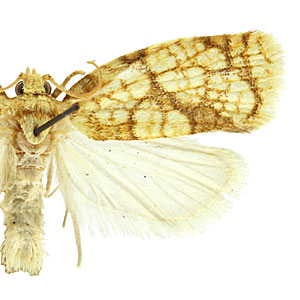Adult Recognition

FWL: 7.5-10.5 mm
Adults are pale yellow with light-brown markings. Hindwings are white. Males have a forewing costal fold.
Adoxophyes negundana and A. furcatana are the only two representatives of the genus Adoxophyes in the Nearctic. These two species are difficult to separate using forewing pattern: in general, the median fascia is narrower in A. furcatana, although this character does not appear to be consistent across all individuals. Freeman (1958) states that male genitalia of A. furcatana have more cornuti (greater than four) and less sharply elbowed gnathos arms than those of A. negundana.
Both species of Nearctic Adoxophyes are similar to Adoxophyes orana and might be confused with this Palearctic species if it were discovered in North America. It is not known if Nearctic Adoxophyes are attracted to A. orana pheromone.
Larval Morphology

Larval morphology is undocumented for this species.
Biology

Adults are present June to August. Larvae feed in rolled sycamore leaves.
Host plants
Larvae of A. negundana have only been recorded feeding on Platanus (sycamore).
| Family | Genus/species | Common name |
| Platanaceae | Platanus L. | sycamore |
Distribution

Adoxophyes furcatana is widely distributed in eastern North America.
References

Freeman, T. N. 1958. The Archipinae of North America (Lepidoptera: Tortricidae). The Canadian Entomologist Supplement 7 (Vol. 90): 1-89.

